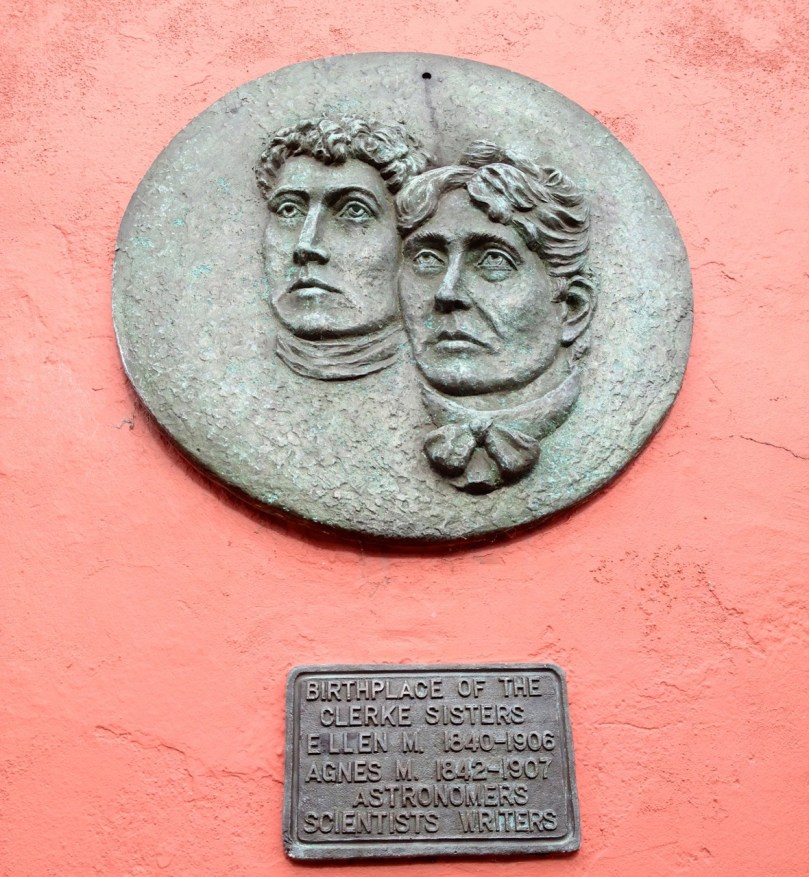 Commemorative plaque in Skibbereen
Commemorative plaque in SkibbereenNOTE: I have rewritten this post and substantially updated it. See, from Sept 2023, Storm Agnes: Agnes Clerke of Skibbereen and Nineteenth Century Astronomy.
What follows is the original post, from 2015.
Wandering around Skibbereen, I came across a plaque on a once-imposing pink building – it showed two women, the Clerke sisters, who had grown up in the house. Intrigued, I searched for more information and what I found astonished me.
Agnes, Ellen and Aubrey Clerke, the offspring of John William Clerke (who managed the bank located on the ground floor) and Catherine Mary Deasy, were all brilliant, scholarly and published writers, each in their own fields. The Clerke (Protestant) and the Deasy (Catholic) families had long and solid histories in West Cork and lived through the awful famine period of Skibbereen during which they were said to be benevolent (see Paddy Leahy’s piece in The Journal of the Skibbereen and District Historical Society, Vol 7, 2011 for more on John and Catherine). John had been educated in Trinity and the children grew up in the 1840s and 50s with access to their father’s extensive library, his telescope and his chemistry experiments. The telescope, according to Mary Brück’s biography, was equipped with a chronograph for timing the transits of stars across the meridian. With this arrangement Clerke was able to provide a time service for the town of Skibbereen, which was as yet unconnected to the outer world by either railway or telegraph.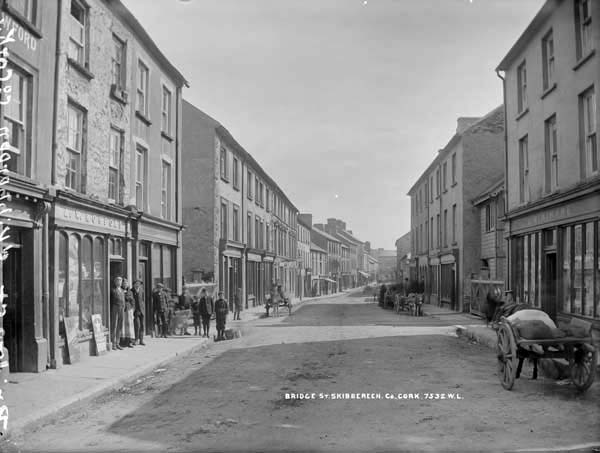 Bridge Street, Skibbereen, 19th Century. National Library Collection
Bridge Street, Skibbereen, 19th Century. National Library CollectionThe sisters were tutored by their mother to a high proficiency in music, Latin and Greek. (Catherine played Irish music on the harp and retained her ability to entertain well into her 80s.) Insatiably curious, they devoured knowledge and by 15 Agnes had already begun to write a history of astronomy – a book that would later count as her magnum opus. While Ellen and Aubrey distinguished themselves mainly (although not exclusively) in literature and law, Agnes went on to become one of the foremost science writers of her day. Devoted to each other, none of the siblings ever married and the family lived together in harmony and supported each other’s endeavours to the end.
Living in Italy for ten years, Agnes and Ellen studied extensively in the excellent libraries in Rome and Florence, becoming proficient in several languages and going to primary sources to research their interests. Thereafter, the family settled in London. Although she started off with a wide range of topics, Agnes over time concentrated on writing about astronomy. Her first published pieces (one about Copernicus, the other about the Mafia!) appeared in the Edinburgh Review in 1873. This was the equivalent, as Perry O’Donovan points out in an essay for the Skibbereen and District Historical Society Journal (Vol 9, 2013), of an unknown writer today being published in the New Yorker.The depth and scope of Agnes’s scholarship is awe-inspiring. To read through her History of Astronomy during the Nineteenth Century (available online through Project Gutenberg) is to see a brilliant mind at work. Her purpose in writing it was to embody an attempt to enable the ordinary reader to follow, with intelligent interest, the course of modern astronomical inquiries, and to realize (so far as it can at present be realized) the full effect of the comprehensive change in the whole aspect, purposes, and methods of celestial science introduced by the momentous discovery of spectrum analysis. This IS the rocket science of her generation, encompassing chemistry, physics, mathematics, history of scientific thought, cosmology, the most up to date observation and measurement techniques – in short, the disciplines that made up the emerging science of astrophysics.
Take a look, for example, at the headings for her Chapter IV: Chemistry of Prominences—Study of their Forms—Two Classes—Photographs and Spectrographs of Prominences—Their Distribution—Structure of the Chromosphere—Spectroscopic Measurement of Radial Movements—Spectroscopic Determination of Solar Rotation—Velocities of Transport in the Sun—Lockyer’s Theory of Dissociation—Solar Constituents—Oxygen Absorption in Solar Spectrum. Looks pretty frightening for a non-scientist, doesn’t it? And yet, this book was one of the best-sellers of the day. Agnes had a unique ability to absorb and compile knowledge and then to lay it out for the non-specialist. (I got through the first chapter with little difficulty.) She is rightly credited as the founder of what is called today Popular Science. Her books (she wrote many more) and articles sold well and she made a good living from her writing. However, she was a woman, and a non-practitioner (that is, she didn’t work in an observatory, although she spent time in one) and many in the predominantly male science establishment of Victorian Britain were sceptical of her knowledge and resentful at her success. But as they read what she wrote most were won over by her erudition and her ability to present their complex findings to a wide audience. Although she was a member of the British Astronomical Association, as a woman she was ineligible to be a member of the prestigious Royal Astronomical Society and had to call in favours to be allowed access to their library. But eventually even that bastion of male scientific privilege was forced to acknowledge her achievements and appointed her and her great friend Lady Margaret Huggins (another Irish astronomer) as honorary members.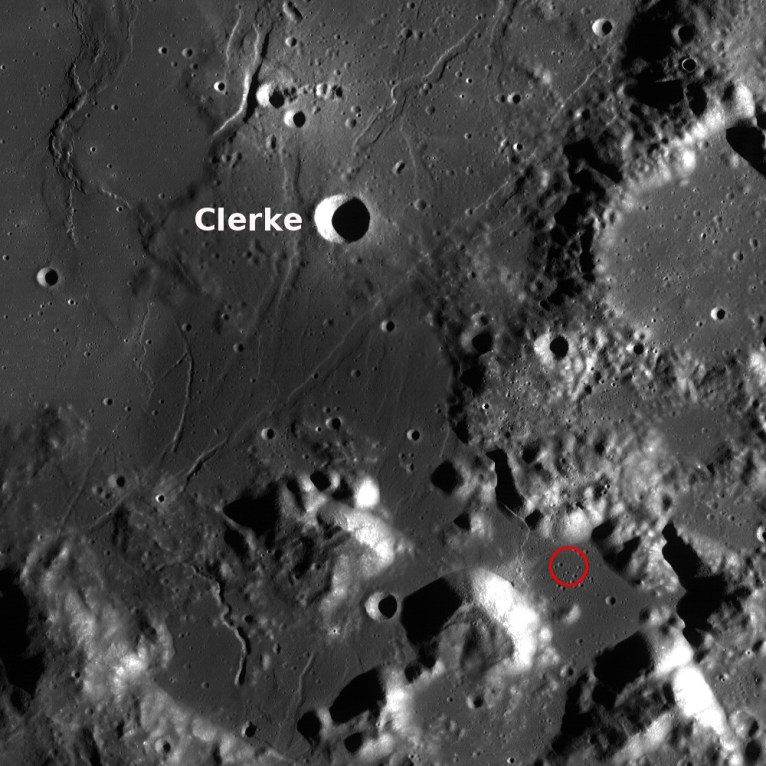 The Clerke Crater
The Clerke CraterRecently, however, Agnes has been paid a high honour. A crater on the moon, near the Apollo 17 landing site, has been named the Clerke Crater by the International Astronomical Union.
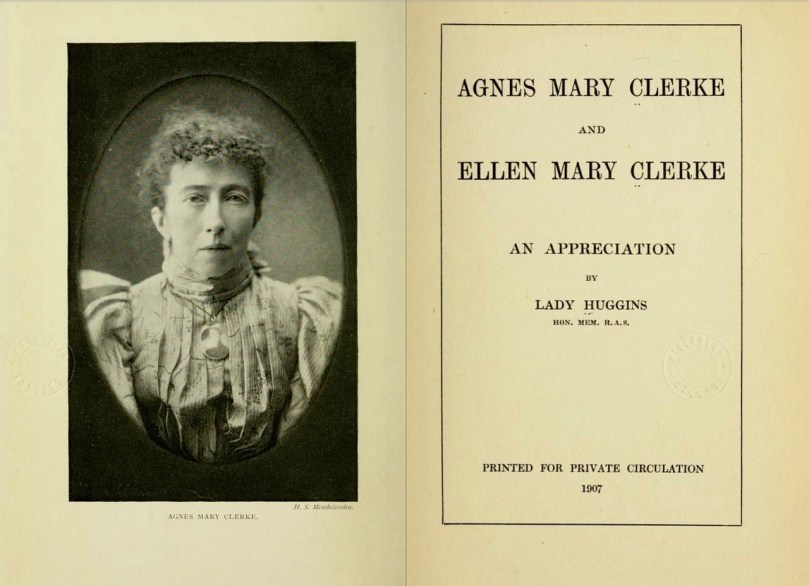 Huggins memoir
Huggins memoirMargaret Huggins penned a small memoir about Agnes and Ellen Clerke after their deaths. However the real authority on Agnes’s life and scholarship was Mary Brück, a fellow astronomer, yet another Irish woman (from Meath) and author of Agnes Mary Clerke and the Rise of Astrophysics.
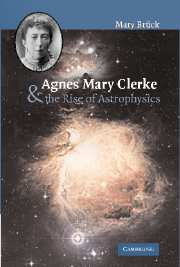 Brück biography
Brück biographyOf Agnes, she said: This remarkable woman, educated solely within her own family and through her own private studies, not only kept abreast of astronomical progress world-wide but also had a genuine understanding of the matters on which she reported and the gift of communicating them through her fluent and prolific writings. Her books – in particular her Popular History of Astronomy during the Nineteenth Century, first published in 1885 and reprinted over almost twenty years – are treasured by historians and by amateur lovers of astronomy alike as sources of reliable and enjoyable information on that period.
I loved her description of Agnes at the height of her powers: Agnes Clerke in her sixties had become a sort of mother figure among astronomers, tactful, kind, helpful.
Ellen and Aubrey deserve their own posts (now written, see From Skibbereen to the Moon Part 2: Ellen and Aubrey Clerke). However, it does seem apt to close this piece on Agnes with a quote from one of Ellen’s poems, Night’s Soliloquy:
…are not hidden things
Reveal’d to science when with piercing sight
She looks beneath the shadow of my wings
To fathom space and sound the infinite?
Discover more from Roaringwater Journal
Subscribe to get the latest posts sent to your email.





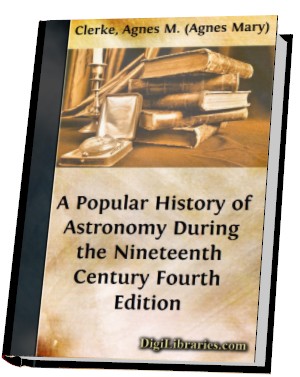






Dear FInola, I don’t know if this site is still live but I am preparing a talk about Agnes Mary Clerke for the British Astronomical Association (britastro.org) to be given at our Autumn meeting in Armagh on 7th September this year – 2019. We have her signature and some letters in our Archives at the BAA. Like you, I came across her plaque and wanted to know more and am now submitting an application to have a placque put at her bohouse in Londodn where I currently live.
LikeLike
Thank you, Janice. I will respond by email.
LikeLike
Dear Finola this is a great article it was sent to me by a relative, Im a relative of Ellen and Agnes Clerke, I would like to be in contact, thank you
LikeLike
I came upon your site, most fortunately, though your mentioning the artist Sheena Jolley. It is wonderful. Your eye catching heading on this piece had me think it was something to do with the Kaiser Wilhelm and the Skibbereen Eagle having its eye on the self same Kaiser. But no, I was totally wrong. Your informative blog posting on the Clerke sisters was a delight to read. Thank you!
LikeLike
Hi Roisin. Nice to hear from you and so glad you liked this piece. I want to do one on her sister, Ellen, as well. Soon.
LikeLike
An amazing family and life. Another story that bears witness to women’s struggle for equality.
LikeLike
Astronomy seems to have attracted a lot of women – she broke ground, I guess.
LikeLike
Fascinating, and Miss Clerke across the road must be related in some way. Apart from all their achievements, the house is fascinating too isn’t it?
LikeLike
I asked Miss Clerke and she said no. Yes – house must have been quite grand, with a large garden out back for the telescope.
http://www.roaringwaterjournal.com
>
LikeLike
I bet she’d be pleased to have a hole in the moon named after her – who wouldn’t?!
LikeLiked by 1 person
Fantastic story!
LikeLiked by 1 person
Thank you, YS!
LikeLike
Mary Bruck, her biographer, was stepmother of Peter Bruck, former professor of Geology at UCC. His daughter Joanna, is aleading Bronze Age archaeologists,
LikeLike
And i understand that Mary was herself a scientist of note?
LikeLike
Reblogged this on West Cork History.
LikeLike
Thankfully there is at least a plaque and now your extensive report Finola.
LikeLike
To be fair, there is quite a bit about Agnes on the internet so she hasnt’ been forgotten by the Women in Science interest group at least.
LikeLike